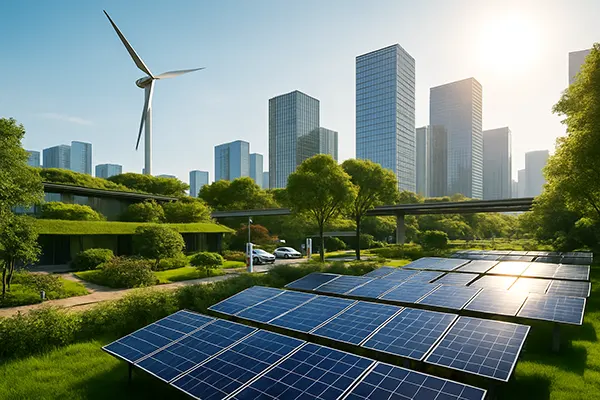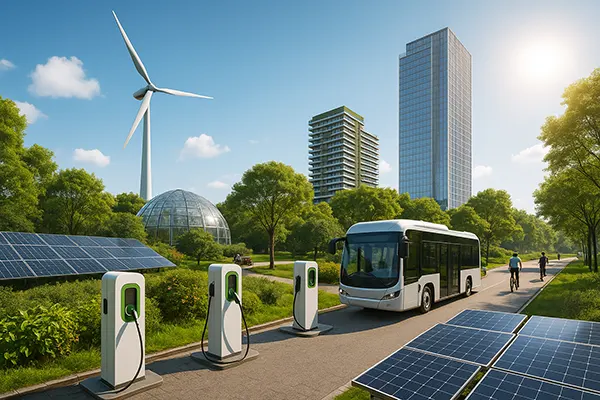
Green Energy Hubs: How Renewable Technologies Integrate into Urban Environments
In 2025, cities worldwide are undergoing a significant transformation as renewable energy technologies become an integral part of urban planning. These so-called “green energy hubs” combine solar, wind, geothermal, and other clean solutions into community spaces, improving both energy efficiency and sustainability. Beyond simply generating power, these hubs serve as innovation centres, where energy infrastructure is integrated with public facilities, residential areas, and transport networks, contributing to reduced carbon emissions and improved air quality in densely populated areas.
Urban Integration of Renewable Energy Hubs
In recent years, municipalities have been adopting comprehensive energy transition strategies that position renewable energy hubs at the core of urban infrastructure. Rooftop solar panels, micro-wind turbines, and building-integrated photovoltaics are no longer experimental features—they are now standard in new residential and commercial projects. By embedding these systems directly into city architecture, urban areas reduce dependence on fossil fuels and increase resilience against energy supply disruptions.
One of the most significant trends is the use of mixed-use renewable hubs. These combine energy production with public amenities such as green parks, electric vehicle charging stations, and shared working spaces. This approach allows renewable technologies to blend seamlessly into the urban environment without compromising space or functionality.
In 2025, digital energy management systems are also a crucial element in hub integration. These systems optimise production and consumption, balancing renewable output with demand. AI-powered analytics enable cities to forecast usage patterns, minimise energy waste, and store surplus power for peak demand periods.
Examples from Leading Cities
Copenhagen has become a model for integrating offshore wind into its city-wide power supply while combining it with urban heating systems. This dual use of renewable energy ensures year-round efficiency, even during colder months. The city’s smart grid network coordinates energy flows between residential buildings, transport systems, and industrial zones.
In Singapore, vertical solar farms and rooftop gardens are integrated into high-rise complexes, maximising limited space. This approach supports both local food production and clean energy generation. The city’s Marina Barrage also acts as a renewable hub by combining water management, public recreation, and solar power generation.
Meanwhile, in Vancouver, community-based energy hubs allow residents to co-own and benefit directly from local renewable systems. These hubs are often connected to district energy networks, supplying heat and electricity efficiently to surrounding neighbourhoods.
Technological Innovations Driving Green Energy Hubs
Technological advances in renewable systems have accelerated their adoption in urban environments. High-efficiency solar panels, capable of generating power even under low-light conditions, make it possible to use renewable energy in climates with fewer sunny days. Lightweight, flexible solar films are increasingly applied to building facades and even urban furniture, turning every available surface into an energy generator.
Energy storage has also seen a breakthrough, with new battery chemistries such as sodium-ion and solid-state cells offering longer lifespans and greater safety than traditional lithium-ion batteries. These innovations allow energy hubs to operate independently from the central grid during outages or peak demand.
Smart microgrids form the backbone of modern renewable hubs. These decentralised networks can function autonomously or connect to the main grid as needed, offering greater reliability and reducing the risk of large-scale blackouts. AI algorithms manage these grids, ensuring that energy flows where it is needed most.
Integration with Urban Mobility
Electric vehicle (EV) infrastructure is now an inseparable part of green energy hubs. Charging stations powered entirely by renewables are strategically placed near public transport hubs, reducing the carbon footprint of daily commuting. Some cities have gone further by incorporating wireless charging into roads and parking areas, making EV use more convenient.
Public transport systems are increasingly electrified, and many are powered by renewable energy produced within the city. Trams, buses, and even ferries run on electricity supplied by local hubs, cutting urban transport emissions significantly.
Shared mobility solutions, such as e-bikes and electric scooters, are linked to hub-based charging stations, promoting sustainable last-mile connectivity while reducing reliance on private cars.

Environmental and Social Impact of Renewable Hubs
The environmental benefits of urban renewable hubs are clear—reduced greenhouse gas emissions, improved air quality, and lower reliance on non-renewable resources. However, their social impact is equally significant. These hubs often serve as community gathering spaces, fostering collaboration and awareness around sustainability.
Educational programmes hosted at these hubs inform residents about energy efficiency, climate change, and the benefits of renewables. Some hubs offer real-time dashboards displaying energy production and consumption, helping people understand the direct impact of their actions.
From an economic perspective, hubs create local jobs in installation, maintenance, and energy management. This not only supports green industry growth but also strengthens community resilience against global energy market fluctuations.
Policy Support and Future Outlook
Government incentives, regulatory frameworks, and public-private partnerships have been critical in scaling renewable hubs. In 2025, many cities are implementing mandatory renewable quotas for new developments, ensuring that every project contributes to clean energy goals.
International collaboration between cities has also accelerated progress. Networks like the C40 Cities initiative share best practices and technical expertise, enabling faster implementation of renewable projects worldwide.
Looking ahead, advances in hydrogen production, carbon capture, and urban energy storage are likely to enhance the capabilities of renewable hubs. As these technologies mature, cities will move closer to achieving full energy independence and climate neutrality.
